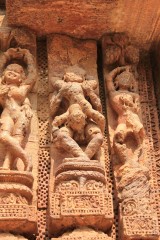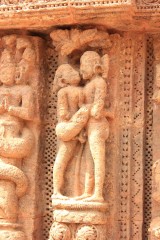11/30/2011
Tantrism
A philosophy I quite like:
"Although it would be ridiculous to say that eroticism in art or religion began in any one place, it is certain that the specific philosophy known as “Tantra” began in India. It also reached its highest artistic
expression there. Tantric art reached its zenith in the temples dedicated to Shiva at Khajuraho and Orissa.
“Tantra” is a Sanskrit word taken from the root tan-, “to expand.”
“Tantrism” is a form of religious practice that takes elements from its Vedic roots and combines them with elements of Buddhism and Hinduism to form a synthesis with universal roots. Elements of Tantra date back nearly 5,000 years to the Harappan Culture (Indus Valley Civilization, c. 2300–1700 B.C.)
Invasions by the Huns, the Moslems, and Victorian soldiers led to an end of the flowering of Tantrism in India. It continues to this day, but nothing could rival the expression Tantrism found in the Northern Medieval period in India.
Tantra involves esoteric sacramental practice. For instance sexual intercourse is
(Click on “Lire la suite” to read more)
used in a controlled way to symbolize the attainment of oneness with the universe, in which the barrier between the mystic and the god disappears. However, there are crucial differences between tantric embrace and ordinary sexual contact. At the time of completion, the tantric practitioner has absorbed the energy flow into the center of his or her psyche, and experiences the mental and physical conditions present at death.
When Siddhartha Gautama (Buddha) was searching for enlightenment, he abandoned the pleasure palace his father had built for him, and set out in the world. He felt he had to rid his mind of desire, and as a means to this end, he denied all the body's desires, culminating in a fast that left him little more than a skeleton. He meditated constantly during his fast, but was unable to achieve the final breakthrough that would allow him to pierce the veil of maya (illusion world).
According to Tantric teaching, he failed because it is not by denying the body’s desires that one can achieve enlightenment. Rather, the more one tries to deny the body’s desires, the stronger they become. In Tantrism, the aim is to use the body’s desires to generate energy that can be channeled into spiritual growth. “Perfection can be attained easily by satisfying all desires,” reads the Guhya-Samaj Tantra.
According to Tantric teachings, Buddha only achieved enlightenment when he broke his fast and ate a mixture of rice and milk prepared for him by a young woman. He felt a surge of energy and this time he required only a few hours of meditation to achieve full awareness.
Tantrism involves the ritualized breaking of taboos. The five M’s of madya (wine), mamsa (meat), matsya (fish), mudra (fried cereal), and maithuna (sexual intercourse) are all ritual elements and reminders of yogic processes. The most important of these is sexual intercourse.
All primitive mythos include fertility rites and mother goddesses, but in Tantrism, the union of male and female takes on cosmological implications. In classical Hinduism, the lingam of Shiva is the center of worship. In Tantric Hinduism, the yoni of Shakti (Shiva’s consort) is added to the lingam of Shiva to form a symbol incorporating the genitals of both sexes, thereby symbolizing the creation of the universe.
Another important aspect of Tantra is meditation, which involves geometric patterns called mandalas and spoken phrases called mantras.
Mandalas are geometrical representations of Tantric concepts. They generally involve interconnected squares, circles, and triangles."
Source: here
Also to be read: here
My pics of Konark: here















The comments are closed.